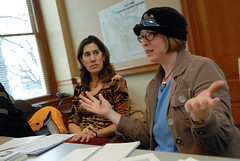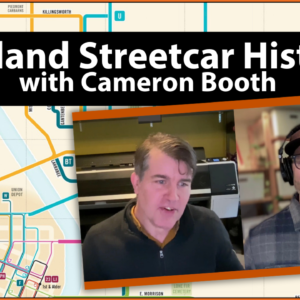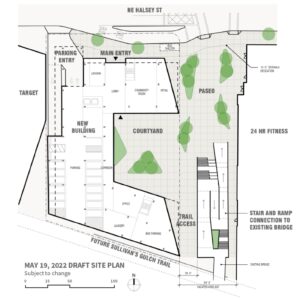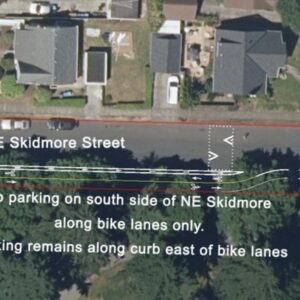“Both projects are focused on a livable future for Portland. And this joint presentation opportunity gives us an excellent opportunity to specifically address the issue of how well bicycling and streetcar can play together as we build our livable streets.”
— Ellen Vanderslice, project manager for the Bicycle Master Plan Update
The City of Portland Bureau of Transportation has announced that the upcoming public open houses for the Bicycle Master Plan Update project will be combined with open houses for the Portland Streetcar System Plan.
Ellen Vanderslice, Bike Master Plan Update project manager, says she believes this new scheme has several benefits. When I asked her why PBOT decided to combine these important events, she gave several reasons.
PBOT has been asked to shave millions of dollars from their budget and, according to Vanderslice, putting these two open houses together is an “opportunity to save the taxpayers money.” It’s also, she says, a result of, “a motivation for staff to look for efficiencies.”
In addition to belt-tightening, Vanderslice says these joint open houses have been planned to save “the time and energy of our citizen advocates.” Both projects were already slated to go out for public review and comment in roughly the same time period, so it made sense, Vanderslice explained, to combine these outreach events, “if only to avoid constituent fatigue”.
PBOT also thinks combining the outreach components of these projects will help them reach a wider audience. Again, Vanderslice referred to cost savings, saying, “we can pool the projects’ resources for outreach. Both projects are focused on a livable future for Portland. And this joint presentation opportunity gives us an excellent opportunity to specifically address the issue of how well bicycling and streetcar can play together as we build our livable streets.”
As we’ve reported in the past few weeks, there is a renewed sense of urgency between bike planners and streetcar planners. BikePortland’s Libby Tucker wrote a two–part, In-Depth story about it last month and Streetcar advocate Chris Smith wrote a follow up.
I applaud the continued effort to integrate planning of streetcar and bikes. However, there is much more to the Bike Master Plan than just how bikes integrate with streetcar. I have concerns that these joint open houses will dilute the Bike Master Plan outreach effort.
What do you think?
Is this yet another example of bikes getting the short end of the funding stick?
Do you agree with PBOT’s justification for combining these important events?
Do you think this is an exciting idea that will end up making both plans better?
Do you think this is simply a reality the community has to deal with due to shrinking budgets?
I would love to hear your thoughts.
Here’s the schedule of open houses:
- Southeast Portland
Tuesday, May 5 – 4:00 p.m. to 7:00 p.m.
Franklin High School Cafeteria (5405 SE Woodward St.)
East Portland
Wednesday, May 6 – 4:00 p.m. to 7:00 p.m.
David Douglas High School Cafeteria (1500 SE 130th Ave)
North Portland
Monday, May 11 – 4:00 p.m. to 7:00 p.m.
Roosevelt High School Cafeteria (6941 N. Central)
Central City and Northwest Portland
Wednesday, May 13 – 4:00 p.m. to 7:00 p.m.
Portland Building, Room C, 2nd Floor (1120 SW 5th Ave)
Northeast Portland
Thursday, May 14 – 4:00 p.m. to 7:00 p.m.
Grant High School Cafeteria (2245 NE 36th Ave)
Southwest Portland
Monday, May 18 – 4:00 p.m. to 7:00 p.m.
Wilson High School Cafeteria (1151 SW Vermont St)







Thanks for reading.
BikePortland has served this community with independent community journalism since 2005. We rely on subscriptions from readers like you to survive. Your financial support is vital in keeping this valuable resource alive and well.
Please subscribe today to strengthen and expand our work.
What is the point of the streetcar? It isn’t a form of rapid rail. It is a *trolley* that has no speed advantage over a regular bus, or capacity advantage of an articulated bus. I don’t see it as anything other than a bell-and-whistle to increase Portland’s quaintness appeal for tourists. A waste of money, and a nuisance for cyclists.
To ChrisW:
The point of streetcars? What district do you live in? Did you know that all of our loved districts in Portland are named after streetcar lines? Those districts were developed with streetcar transportation in mind, by the streetcar companies. The neighborhoods that we love are/were developed because of streetcars. None of these neighborhoods would have rows and rows of stores, livable neighborhoods, or calm streets without streetcar life.
For example, buses run in the SW. Not quite as dense or walkable as a single neighborhood build on a streetcar line. Much higher traffic speeds. This sprawl has nothing to do with hills. San Fransisco? Very hilly but very livable, all developed for communities with streetcars.
What about Indianapolis or Dallas? It was not developed with streetcars and just look at the difference. But just look at there buses. Interested in moving?
ooohh more of this discussion….
I agree with chris…what’s the point of streetcars? why not spend the money to upgrade our existing bus system to make it more functional for more people?
The whole street car thing is what you call Developer Oriented Transit. Taxpayers fund the expensive trolleys, planners increase density and heights along the lines, developers build big ass condos, rents go up, livability goes down, and bikers take huge diggers in the tracks. And then, cause it’s expensive to run the new trolleys, Tri Met cuts bus service in other areas.
As for history. I recon that if buses were around back in the day, they would have served the same development function as streetcars. Now, buses, cars, and bikes fill the role of the old streetcar lines.
Lance, nice history lesson, but no one asked “what was the point of streetcars 100 years ago”
Why can’t we have rubber-tired streetcars? Dispense with the track infrastructure – just put in the overhead power lines.
Less hazard for bicycles. Easier and cheaper to build initially and to reroute if necessary for some reason.
The argument I’ve heard for laying rails is the economic development one. A business is more likely to invest in a neighborhood when it sees tangible infrastructure investment that can’t easily be altered.
So the transportation aspect seems to have taken a back seat to the economic development angle.
Lance,
I understand what the point of streetcars were *then*. They had an obvious advantage over horse-drawn carriages. That said, I don’t see their point in the present day.
As far as dense development goes, you can do that by liberalizing zoning codes. Allow for mixed use commercial/residential on arterials, and higher density residential within neighborhoods. (Neighborhood associations, of course, will debate what level of density is acceptable — most would go for cottages, flats or townhouses before they would accept a tower). I don’t see that streetcars are necessary to facilitate that, nor do I think it should be subsidized.
Even as a carfree cyclist, I can’t get on board the public transit bandwagon. Although I believe that options should be made available, I believe that people prefer the automobile because it is a flexible, personal form of transport that doesn’t restrict one to timetables or specific routes. A bicycle is more similar to a car than it is to public transit in this respect.
The only form of rail that would be truly advantageous would be something like Vancouver’s Skytrain, which never has to compete with traffic or stop for signals ever. Excluding projects such as these, I’d favor scraping the transit agencies and relying upon private jitney and shuttle operators.
The MAX would be great, if it weren’t for the grindlingly slow downtown/Lloyd Center portion. If they eliminated half of the stops in those two areas and elevated the track, it might not suck to ride as much as it currently does. The Streetcar aims to replicate the MAX’s shortcomings.
“As far as dense development goes, you can do that by liberalizing zoning codes. Allow for mixed use commercial/residential on arterials, and higher density residential within neighborhoods.”
That doesn’t work. You must have streetcars. Just look at Seattle and Vancouver, BC…they are total ghettos!
I LOVE that we’re going to ask citizens to think about these two major infrastructure investments for the City together. Thinking about these systems as drivers for reshaping Portland into a more sustainable form in a holistic way is great.
In defense of streetcars. The investment in infrastructure that street car lines represent spur densification and redevelopment that buses do not. If Portland is serious about infill they should focus on building street cars, especially of the east side of the Willamette.
to chrisw:
You have to be a fool if you think that everyone should either drive or bike to get to where they are going. Just think of the congestion of Portland’s roads if everyone on the transit system drove. Bikes would be competing for a scares and finite resource (the right of ways) and bike would slowly get pushed out. This is exactly what has been happening on both the east coast and midwest. Virtual all people drive, virtual no one bikes, and transit is a joke.
I also live without a car and bike year round. But when older family members come to town to visit, they can’t bike, it’s nice to have the public transit infrastructure to get around.
Buses just don’t work for all people and all locations. There is a huge group of people that won’t ride buses. Period. You can see tracks and know when it’s turning, you can’t say the same for buses.
I guess regardless of what I or anyone else says, you seem to take the right wing approach to transportation.
If I were actually right-wing on transportation, I would be anti-bike 😛
No, my opinions on transportation are sufficiently unorthodox to alienate both the right and left. I just think that if you are going to do rail, do *rapid* rail, and rather than streetcars and light-rail lines that spend half to all of their journey on street level.
I hate buses too, but I do like shuttle vans. I think most people would like them were they actually legal to operate.
East coast and midwest? I guess it depends upon the city. I’m sure the suburbs are bad, but I hear Chicago, Madison, Minneapolist, Pittsburgh, NYC, Boston, and DC are great bike towns.
Groan, not another anti-streetcar debate topic!
I think this should be really interesting to check out. I would love to see streetcars built to the eastside, particularly down Hawthorne and Burnside.
I can’t believe how crowded the 14 bus is, I don’t know how many times I have been turned away from a full bus. Streetcars can carry close to 2x the capacity of a bus. Sure, they could run a bus ever 3 minutes on that line, but since Trimet is actually cutting back service (and eliminating 12 lines), thats not going to happen.
More people tend to ride the streetcar, shorter loading times, no noise or exhaust pollution, smoother ride, faster acceleration, easier to load your bikes on board.
Amen carless in pdx
@ chrisw #7: Elevated would be OK, but I’ve thought all along that the MAX should run underground through the downtown core, just like the commuter rail systems in most major metropolitan areas.
@ #14 If you were following the discussion you would know that one of the reasons TriMet is cutting back on bus service is because of the expense of their rail projects and service.
Plus the streetcar may not generate exhaust along it’s route, but the electricity it requires either kills salmon or generates CO2 at a location outside of PDX. You do know where electricity comes from, yes?